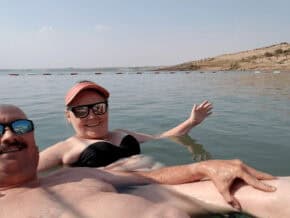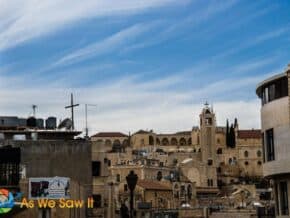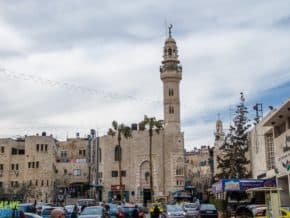Places to stay
Way up in the north, in the little finger of Israel that squeezes between the Syrian and Lebanese borders, is a beautiful spot of heaven known as Tel Dan Nature Reserve. Holding the remains of a 5000-year-old city, Tel Dan is one of the most important archaeological and historical sites in Israel.
Often little more than a hill or mound, a tel is what is left of an ancient city. The ancient city that stood here during the time of Solomon was the northernmost city of the Kingdom of Israel, “They renamed the town Dan after their ancestor, Israel's son, but it had originally been called Laish.” (Judges 18:29)
Tel Dan Nature Reserve
Few foreign tourists visit the Tel Dan Nature Reserve, but it's a very popular place among Israelis. The locals love to picnic here, hike the forests and trails, and enjoy the refreshing waters of the Dan River.
And no wonder! With so many waterfalls, wading pools, and lush foliage, it’s delightful.
We stopped to sample the water from one of the many springs in the park. They are the source of the Dan River, whose clear waters flow into the Jordan River and on to the Dead Sea.

Archaeological discoveries at Tel Dan
Sure it's beautiful, but Tel Dan is also the site of extremely important archaeological discoveries. Excavations there have exposed some really important finds:
- a stone with an inscription about the House of David (the oldest document to mention King David from the Bible)
- the only surviving monumental temple complex, King Jeroboam’s temple, built to challenge Jerusalem for religious supremacy.
- the world’s oldest-known gated archway, built 1500 years before the Romans (supposedly) invented the arch.
- a stone wall dating from the Iron Age
- remains of Canaanite and Israelite cities
- an elevated platform inside the city gate, where judges sat to preside over lawsuits brought before the city elders.

Dan in the Bible
The city was standing before Abraham, and even before Sodom and Gomorrah, when it was known as Laish. It was the northernmost city in the Biblical land of Israel. It wasn't important in history until the power struggle after King Solomon's death – around 930 BC – when the nation split into the two kingdoms of Judah and Israel.
At this point, Dan became a center of apostasy and Baal worship:
26 Jeroboam thought to himself, “The kingdom will now likely revert to the house of David. 27 If these people go up to offer sacrifices at the temple of YHVH in Jerusalem, they will again give their allegiance to their lord, Rehoboam king of Judah. They will kill me and return to King Rehoboam.” 28 After seeking advice, the king made two golden calves. He said to the people, “It is too much for you to go up to Jerusalem. Here are your gods, Israel, who brought you up out of Egypt.” 29 One he set up in Bethel, and the other in Dan. 30 And this thing became a sin; the people came to worship the one at Bethel and went as far as Dan to worship the other.
1 Kings 12:26-33 NIV

Besides leading them into worshiping other gods, Jeroboam also changed the calendar:
32 He instituted a festival on the fifteenth day of the eighth month, like the festival held in Judah, and offered sacrifices on the altar. This he did in Bethel, sacrificing to the calves he had made. And at Bethel he also installed priests at the high places he had made. (1 Kings 12:32 NIV)
No wonder Dan was the first city the Assyrians targeted when they invaded Israel. God was really ticked.
What's left of Tel Dan
When we visited the site, we focused on the temple complex. It is extremely central in Israel's history. We got to the temple by going past 4000-year-old stone walls. They are still standing because they had been buried for millennia, only revealed during excavations.

We passed through a city gate

… and along a very well-preserved walkway.

We passed some foundations of homes, still with cisterns and grinding stones.

And finally arrived at the “high place” and altar at the worship site.
This is the cultic site where Jeroboam, king of Israel (northern tribes), placed one of the two sacred calves that would lead to Israel's future captivity by Assyria.
A huge metal frame shows the size of the altar, upon which the golden calf once stood.

The nature reserve has incredible views
A little further on, a spot offers fabulous views of nearby Syria.

Our friends pulled out their shofars and played a tribute to Hebrew history.

Visit Tel Dan Nature Reserve
Read more about the Tel Dan excavations on Bible History Daily.
- Address: North of Rte. 99, Dan, Northern District, 1224500, Israel
- Hours: Apr.–Sept., Sat.–Thurs. 8–5, Fri. 8–3; Oct.–Mar., Sat.–Thurs. 8–4, Fri. 8–3; last entrance 1 hr before closing




Spent 14 days exploring Israel April/May 2018, and this is one of the locations that I didn’t make (just managed a drive by) that I wish I would have went to. It’s on the list for next time. I really think it’s interesting that you included the shofar in your adventure.
We always try to get into the country’s history and culture when we travel. It was even more fun in Israel because we find Biblical history fascinating. What was your favorite spot on your trip?
In verse 27, the temple of the Lord in Jerusalem is the temple of YHVH, not adonai. Jeroboam is not concerned about the peoples’ religion. He is worried that they will make Rehoboam their lord (master) instead of him. He is putting service to man (himself) above serving God.
That’s a good insight, Kevin, thanks for sharing it. I like how you keep me on my toes. I checked my Hebrew Bible and you’re right that it’s YHVH, not adonai. Thanks for catching that. I’ve corrected the error.
YHVH and Adonai are the same God. What is transliterated YHVH into English is read as Adonai in Hebrew.
יהווה
There is no question that both Israel and Judah worshiped the same god. The previous comment was regarding the actual Hebrew lettering in that verse. In the Hebrew Bible, it is spelled
יהווה. The four letters, read from right to left, are yodh, he, waw and he. Waw is sometimes pronounced vav. Various English Bibles transliterate that word as YHVH or YHWH.
Pronouncing יהווה as Adonai is tradition. The Jews considered the name of God so holy they would not pronounce it aloud. They replaced YHWH with Adonai, but nowhere in the Word is that required.
If you’re interested, there are some interesting insights into this topic on this page: https://www.nehemiaswall.com/nehemia-gordon-name-god
Cheers!